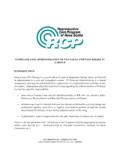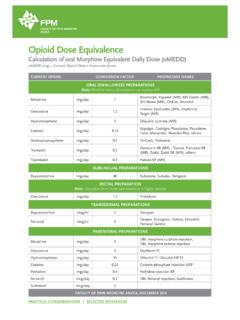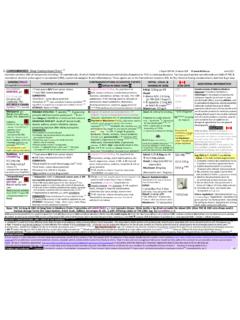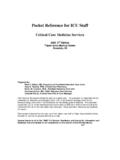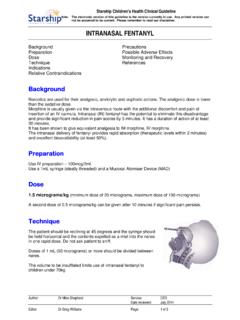Transcription of OPIOID PRESCRIBING RULES FOR WORKERS’ …
1 OPIOID PRESCRIBING RULES FOR WORKERS COMPENSATIONTHE RULES :IN EFFECT MAY 1, 2018 OPIOID prescriptions and outpatient pain management treatment modalities in workers comp claims. An employee who has received OPIOID treatment for more than 12 consecutive weeks immediately preceding May 1, 2018. Any medications administered in a health care setting. Treating cancer-related , employees and carriers/employers can agree to a course of treatment that may be inconsistent with the Industrial Commission may waive the RULES on a case-by-case basis upon TO: DO NOT APPLY TO: NOTE: Providers and employees should work through carriers/employers request a waiver, the employee (or his/her attorney) should file a medical additional details and guidance, access the Industrial Commission s website: [CSRS REQUIREMENT: IN EFFECT NOVEMBER 1, 2018]AN OVERVIEW BY THE NORTH CAROLINA MEDICAL SOCIETY - MAY 20181 OPIOID PRESCRIBING RULES FOR WORKERS COMPENSATIONTHE FIRST OPIOID PRESCRIPTIONB efore PRESCRIBING , the provider must:a.
2 Document that non-pharmacological and non- OPIOID therapies are insufficient to treat Review the employee s 12-month history in the CSRS. Document results and potential Impose limits on quantity and dose: Providers must write for the fewest days necessary to treat the employee s pain, and not more than a 5-day supply. EXCEPTION: 7-days supply allowed, but only for post-op pain immediately following surgery Providers must write for the lowest effective dosage, not to exceed 50 morphine equivalant dose (MED) per day using a short-acting : If the employee was on OPIOID therapy immediately prior to the prescription, the provider may exceed 50 RESULTSAN OVERVIEW BY THE NORTH CAROLINA MEDICAL SOCIETY Consider ordering any other non- OPIOID treatment for pain.
3 Consider a co-prescription for naloxone if PRESCRIBING an THE EMPLOYEE IS IN THE ACUTE PHASE, PROVIDERS SHOULD:REFER TO THESE RULES WHEN THE EMPLOYEE IS IN THE FIRST 12 WEEKS OF TREATMENT FOR PAIN FOLLOWING: An injury or occupational disease, or Subsequent aggravation of an injury or occupational disease, or Surgery for an injury or occupational PRESCRIBING IN THE ACUTE PHASE Write more than one OPIOID prescription at a time. Prescribe an alternative OPIOID preparation, unless oral opioids are contraindicated. Prescribe fentanyl for pain. Prescribe benzodiazepines for pain or as muscle THE EMPLOYEE IS IN THE ACUTE PHASE, PROVIDERS CANNOT:NOTE: If the employee is already taking a benzo or carisoprodol, the provider must first advise the employee of the risks of taking an OPIOID in combination and inform the prescriber of the benzo/carisoprodol of the OPIOID THE EMPLOYEE ALREADY RECEIVED 35-37 DAYS SUPPLY OF AN OPIOID IN THE ACUTE PHASE?
4 IF a presumptive urine drug test (UDT) of the employee and document results; Random and/or unannounced administration is RESULTSABNORMAL/UNANTICIPATED RESULTSA dminister a validated OPIOID risk assessment and screening tool and document results. Screening tool examples: NIDA Quick Screen and NIDA-Modified ASSIST Screener & OPIOID Assessment for Patients with Pain (SOAPP)If the UDT is positive for undisclosed drugs or negative for opioids, the provider must order a confirmatory test. The Provider test results before PRESCRIBING additional and document whether any data from the earlier steps indicate increased risk of OPIOID -related harm to the employee. If so, and OPIOID therapy continues, also document the OVERVIEW BY THE NORTH CAROLINA MEDICAL SOCIETYDIAGRAM A: REQUIREMENTS IN THE ACUTE PHASE SUBSEQUENT OPIOID PRESCRIPTIONB efore PRESCRIBING additional acute-phase opioids, the provider must:a.
5 Document that non-pharmacological and non- OPIOID therapies are insufficient to treat Review the employee s 12-month history in the CSRS. Document results and potential Drug Testing Requirement: Complete the steps in Diagram A (see graphic below).d. Administer a validated OPIOID risk assessment and screening tool (see graphic below).e. Impose limits on quantity and dosage (see graphic below).If the employee is already taking a benzo or carisoprodol, the provider must first advise the employee of the risks of taking an OPIOID in combination and inform the prescriber of the benzo/carisoprodol of the OPIOID and document the effectiveness of the higher dosage at all subsequent a limited supply after completing assessment / screening limits on quantity and dose Providers must prescribe the fewest days necessary to treat the employee s pain; no specific limit on days supply.
6 Providers must write for the lowest effective dosage, not to exceed 50 MED/day using short-acting : Providers may write 50-90 MED/day, but must document the justification for the higher dosage with a comparison of expected benefits and risks to the employee. OPIOID PRESCRIBING RULES FOR WORKERS COMPENSATION3AN OVERVIEW BY THE NORTH CAROLINA MEDICAL SOCIETYB efore PRESCRIBING , the provider must:a. Document that non-pharmacological and non- OPIOID therapies are insufficient to treat Review the employee s history in the CSRS before PRESCRIBING or every 3 months, whichever is more frequent. Document results and Drug Testing Requirement: Complete the steps in Diagram B (see graphic on next page).d. Administer a validated OPIOID risk assessment and screening tool if necessary (see graphic on next page).
7 E. Impose limits on quantity and dosage (see graphic on next page). Consider ordering any other non- OPIOID treatment for pain. Consider a co-prescription for naloxone if PRESCRIBING an OPIOID . Request authorization before PRESCRIBING methadone for pain. Request authorization before PRESCRIBING both an OPIOID and the employee is already taking a benzo or carisoprodol, the provider must first advise the employee of the risks of taking an OPIOID in combination and inform the prescriber of the benzo/carisoprodol of the OPIOID THE EMPLOYEE IS IN THE CHRONIC PHASE, PROVIDERS SHOULD:REFER TO THESE RULES WHEN THE EMPLOYEE CONTINUES TREATMENT FOR PAIN IMMEDIATELY FOLLOWING 12 WEEKS OF OPIOID PRESCRIBING IN THE CHRONIC PHASEWHEN THE EMPLOYEE IS IN THE CHRONIC PHASE, PROVIDERS CANNOT: Prescribe an alternative preparation of a Schedule II OPIOID , unless oral opioids are contraindicated.
8 Prescribe benzodiazepines for pain or as muscle relaxers. Write more than two OPIOID prescriptions at a : The provider must seek preauthorization before PRESCRIBING transdermal : If two are indicated, document the justification. Providers may only write one short-acting and one : OPIOID PRESCRIBING RULES FOR WORKERS COMPENSATIONAN OVERVIEW BY THE NORTH CAROLINA MEDICAL SOCIETYThe provider must seek preauthorization before PRESCRIBING transdermal the employee is new to the provider s practice, administer a validated OPIOID risk assessment and screening tool and document results. Screening tool examples: NIDA Quick Screen and NIDA-Modified ASSIST Screener & OPIOID Assessment for Patients with Pain (SOAPP)If the UDT is positive for undisclosed drugs or negative for opioids, the provider must order a confirmatory test.
9 The Provider a limited supply after completing assessment/screening and document whether any data from the earlier steps indicate increased risk of OPIOID -related harm to the employee. If so, and OPIOID therapy continues, also document the B: REQUIREMENTS IN THE CHRONIC PHASEA PRESUMPTIVE URINE DRUG TEST (UDT) MUST BE GIVEN AT THE START OF THE CHRONIC PHASE, AND 2-4 TIMES PER YEAR TO EMPLOYEES IN THE CHRONIC PHASE. The carrier/employer may authorize additional tests if requested. The 4-test limit without authorization does not apply if the employee is prescribed an OPIOID for the treatment of substance use disorder (SUD).Await test results before PRESCRIBING additional a presumptive UDT of the employee and document results; random and/or unannounced administration is OK.
10 Impose limits on quantity and dose Providers must prescribe the fewest days necessary to treat the employee s pain. Providers must write for the lowest effective dosage, not to exceed 50 : Providers may write 50-90 MED/day but must document the justification for the higher dosage with a comparison of expected benefits and risks to the employee. Review and document the effectiveness of the higher dosage at all subsequent : If a dosage exceeding 90 MED/day is necessary, the provider must seek preauthorization from the carrier or employer. If authorized, the provider must review at subsequent evaluations whether the employee experienced the expected benefits and whether to continue at the higher dosage. NORMAL/ANTICIPATED RESULTSABNORMAL/UNANTICIPATED RESULTS 5 OPIOID PRESCRIBING RULES FOR WORKERS COMPENSATION






